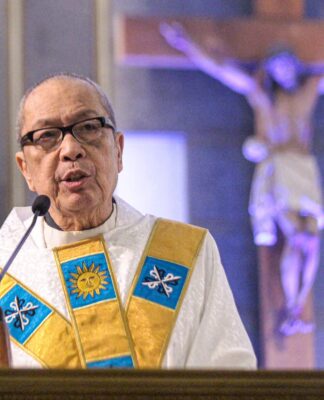 BY INTERNATIONAL standards, the UST Museum of Arts and Sciences still has a long way to go when it comes to preserving its priceless collection of paintings, many of which cannot be displayed simply because of lack of space.
BY INTERNATIONAL standards, the UST Museum of Arts and Sciences still has a long way to go when it comes to preserving its priceless collection of paintings, many of which cannot be displayed simply because of lack of space.
This is partly because the mezzanine of the Main Building which serves as the repository of UST’s heritage was not really meant for a museum, said Maita Oebanda, UST Museum collection management and documentation assistant.
“The Museum started as an auditorium called paraninfo. It’s a multi-purpose gathering hall where rectors would usually deliver their speeches,” Oebanda told the Varsitarian.
In fact, only two percent of the museum’s collection are out on display, the official said.
As a venue for academic discourse, the paraninfo, a major component of the Main Building when it opened at the present UST campus in 1927, can be compared to the modern-day Continuing Medical Education (CME) Auditorium at the St. Martin de Porres Building, Oebanda said.
“The collection started to be transferred inside the paraninfo in the mid-1930’s, more or less during 1936,” Oebanda said.
“There was no place where the collection could be transferred when the University relocated from Intramuros to Sampaloc.”
Thus, the paraninfo, upon its conversion into a makeshift repository, hardly met museum standards, begging structural modifications to help in the preservation of the paintings and other artifacts, Oebanda added.
Museums of high standards rely on engineering to protect and preserve their collections, especially paintings, she added.
“Museums would have equipment that would record humidity fluctuations and ultraviolet presence in order to prevent paintings from further degradation,” Oebanda said. “(Our collection) was housed inside a facility that was not originally meant for museum purposes.”
There are museums which automatically shut the lights off when there are no people inside, to lessen the heat coming off from lights that may affect the artworks’ conditions, she noted.
Aside from structural constraints which limit the 81-year-old museum from exhibiting UST’s entire collection, the location of the UST Museum inside the Main Building reflects the fact that it was not designed to keep artifacts. There are many neighboring offices such as the Registrar’s and Treasurer’s offices and regular human traffic transacting business inside the Main Building.
“What is housed inside the Museum is only two percent of the whole collection that UST has, that if the whole collection would be exhibited, it would take the whole Main Building just to accommodate it,” Oebanda said.
Despite limitations, Oebanda said that the Museum is on a league of its own at the university level, in terms of promoting a “culture of heritage awareness” among Thomasians.
“With the CCCPET (Center for the Conservation of Cultural Properties and the Environment in the Tropics) at the Thomas Aquinas Research Complex, the Cultural Heritage Studies program of the Graduate School, and the Museum, a culture of awareness of our heritage flourishes. The three function as the tripod of cultural heritage awareness in the University,” Oebanda said.
Oebanda underscored the “tripod function” of the three institutions when Cultural Heritage students conducted a “cultural mapping” of Vigan with the support of CCCPET, which was exhibited in the Museum last November.
The support given to the Museum is a luxury worth thanking for, she added.
“Not all universities have a museum and not all museums are as well-funded and as supported as our very own,” Oebanda said, noting that the Office of Museum Administration has adjusted well with the support of the previous administrations.
Back in 1997, then UST Rector Fr. Rolando de la Rosa, O.P. ordered a major renovation of the Museum to house more paintings and collections, thus allowing it to accommodate more exhibitions.
“With the present Museum, we could accommodate more activities like the graduation recital of the Conservatory of Music and the conferment of honoris causa,” Oebanda said.
Heading toward the quadricentennial celebration of UST in 2011, Oebanda described the Museum as the repository of Thomasian history, also considering the fact that it now occupies the old paraninfo which had witnessed the University’s most important events.
“The instrument lays claims to the history of UST and the heritage of the country,” Oebanda said. “When anybody asks what could prove the existence of UST through time, there is no answer but the Museum.”















